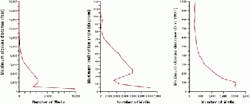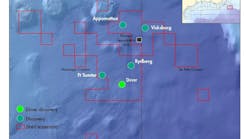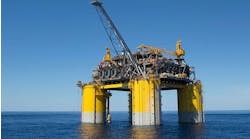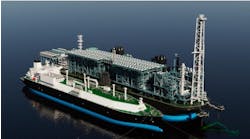DIRECTIONAL DRILLING: Horizontal-departure-to-TVD ratio decline continues in US Gulf
Drilling trends in the 1990s, as presented in the April 2000 issue of Offshore, indicated a majority of extended reach (ERD) wells had horizontal departures in the range of 10,000-15,000 ft. The second and third highest number of wells were in the 5,000-10,000 ft and 15,000-20,000 ft ranges, respectively.
These Gulf of Mexico trends were pushed up by the 1997 Deep Water Royalty Relief Act, which encouraged deepwater drilling by designating geographic areas and allowing deepwater leaseholders to apply for royalty suspensions in these areas. The total number of directional wells drilled in 1998 was 1,116, out of a total of 1,718 wells drilled. Total well counts for 1999 and 2000 are 1,944 for 1999 and 2,072 for 2000, however total directional well numbers are not available yet.
Looking at horizontal departure (Dep) and true vertical depth (TVD) of wells drilled through the mid-1990s, a general "shallowing" trend was evident. The ratio of Dep and TVD increased over this same time interval. This increase in the Dep/TVD ratio was due to a continuing increase efficiency of directional steering systems in horizontal and multi-lateral drilling applications. However, if a linear progression of future activity into deeper waters is assumed, a downward trend should develop off to the right of the graph. A few shallow water wells in the future will continue to be drilled, extending horizontal wellbores and pushing the Dep/TVD ratio greater than five. Some experts expect the majority of ERD wells in the early 21st Century will be drilled with ratios less than two.
The industry is pursuing a number of offshore extended reach projects to be drilled. Conven-tional steerable drilling assemblies will be the dominant drilling technique of choice. These conventional assemblies are limiting the drilling process, instead of contributing to it. However, rotary steerable technologies are emerging as a solution for this problem, extending reach capability even further.
Maximum closure
Horizontal and extended reach wells drilled in the gulf are pushing maximum closure distances to even greater lengths. The US Minerals Management Service maintains a two-year grace period for operators before releasing directional well information. These closure distances versus wells are through 1998, plus early released data of a small number of wells completed during 1999 and 2000. Operators drilling wells from 1998-2000 with the greatest maximum closure distances are listed in the table.
An interesting anomaly in maximum inclination can be seen in the 85-100 degree range. The downward trend in the number of wells with increasing maximum-well-inclination reversed itself and increased slightly over this inclination range. Also, operators completing wells from 1998-2000 with a maximum inclination angle of 85 degrees or better are listed in the table.




